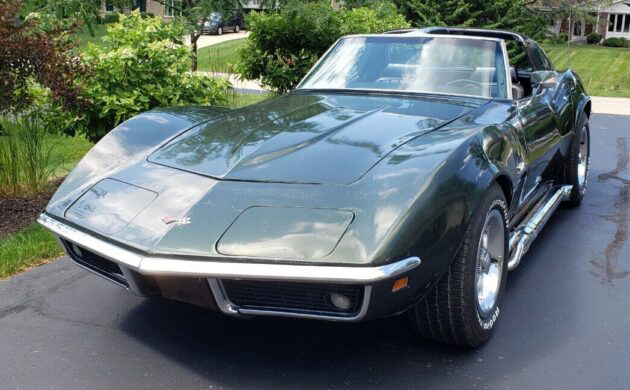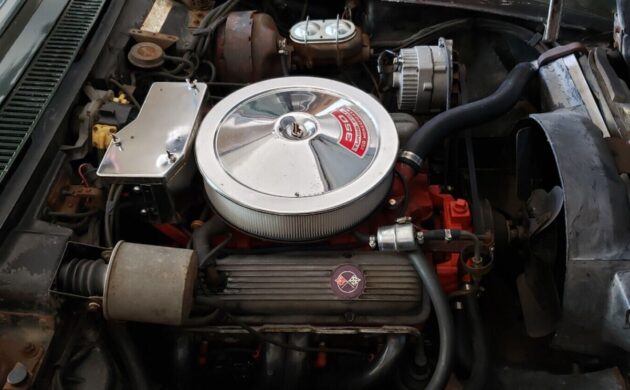Numbers-Matching 4-Speed! 1969 Chevrolet Corvette
The Chevrolet Corvette got a major redesign back in 1968 when the third generation was introduced, so changes for 1969 were minimal, but one significant difference was in the production numbers. More than 10,000 more ’69 models were manufactured than the prior year, with a total of 38,762 C3s rolling off the assembly line, a number that wasn’t surpassed until 7 years later in 1976. With the big block cars getting most of the hype and a bulging hood in 1969, most buyers still chose the small block, which had grown to 350 cubic inches from 327 in the previous model. While the small block cars aren’t particularly rare, many have exchanged hands numerous times and had their original drivetrains swapped out, so it’s refreshing to stumble upon a numbers-matching example like this 1969 Chevrolet Corvette Stingray currently for sale here on eBay. It’s located in Brookfield, Wisconsin with bidding having reached $22,600 so far.
The seller tells us that the previous owner of this C3 had the car for over 50 years and stored it in his dry garage, and claims that the car has only racked up 67,000 miles during its entire life. The Fathom Green paint is not perfect, but it is original and it’s not bad to be more than half a century old, showing some cracking and checking in places plus a few touch-ups over the years. The original N41 side pipes were removed in 1974 in favor of the current Hooker Header pipes, which do have some rust on top, but those are the original rally wheels and they’re wearing a new set of B.F. Goodrich Radial T/As.
The 350 is the original engine, which has never been apart other than receiving a valve job in the early nineties, which the seller says he has a receipt for. The Muncie M-20 4-Speed is also an original piece, and the car is said to run great and shift well through all the gears. Outback is the original G81 Positraction rear end with 3.70 gears, which has recently had the fluid changed with the recommended AC Delco lubricant, and there’s also a new battery and starter for added peace of mind.
The interior is original as well, including the carpet and seat covers, with all of the gauges in the dash said to still be functioning. Everything inside looks overall well preserved, although the factory radio has been replaced with an aftermarket unit that doesn’t currently work. The car still has the metal dealer emblem on the back from Dale Chevrolet in Waukesha, Wisconsin, a tasteful remnant and a credible testament to the car’s originality. There’s no reserve, so the high bidder will be driving this one home. What are your thoughts on this 1969 Chevrolet Corvette Stingray?
Auctions Ending Soon
 2002 Subaru Impreza WRXBid Now9 hours$333
2002 Subaru Impreza WRXBid Now9 hours$333
 1975 Chevrolet Corvette ConvertibleBid Now10 hours$4,000
1975 Chevrolet Corvette ConvertibleBid Now10 hours$4,000
 1964 Ford F-100 Camper CustomBid Now11 hours$2,000
1964 Ford F-100 Camper CustomBid Now11 hours$2,000
 2006 Jeep Wrangler SportBid Now2 days$11,000
2006 Jeep Wrangler SportBid Now2 days$11,000
 1974 Datsun 260ZBid Now4 days$750
1974 Datsun 260ZBid Now4 days$750





Comments
Thoughts: This is a really nice car well preserved. Another thought: If the “recommended AC Delco” rear gear oil is what was recommended in ’69 I’d sure change it for an up to date synthetic oil for longevity of the unit. Example: One of our long term race cars, running the original factory designed differential, had the limited slip installed in the early ’90s and is currently in the car with literally no wear due to synthetic Red Line 80-90 oil. Lot of other good oils out there like Lucas, Valvoline, etc. We use a Lucas synthetic engine oil that quadrupled our bearing life. Either way, this Vette deserves the best it can get. Back to you Mike, tired of thinking so much.
From the ad -“All fluids changed including the Posi-Traction Differential with factory recommended AC Delco lubricants.” This is absolutely the right thing to do. All fluids and associated specifications have and are being updated continually. I am sure GM engineers are keeping on top of these specifications through testing and participation on the various oversight committees that maintain these specifications. If you are really concerned about a specific manufacturers’ lubricant ask to see the test results that they have to back up their claims. Anecdotal evidence can’t replace certified test results.
In the late ’90s the rear end in our 85K mile ’83 GM motor home got a little slack that got me moving to find some different oil for it. Went to a big RV show that GM had a new frame display and two engineers to answer questions. At that time GM would not endorse synthetic oil for their heavy duty chassis line. When I told the engineers what my situation was they both said put synthetic in it. My second RV was a ’99 with a GM chassis that still was recommending only standard gear oil. Needless to say I dumped the factory oil for the synthetic and at 89K, mostly towing our 6,000lb race car trailer, traded it it for another unit with the rear end tight as tick.
Remembered back in the 70’s, changed the oil in my 12 bolt posi and had problems. Can’t remember what it was but was told have to use the factory positraction oil and it worked.
Eaton, who made the 64-79 Corvette Posi units, recommends the use of conventional lubes and GM Posi additive. Synthetics are claimed to be compatible with Posi’s, but people have experienced Posi clatter using synthetic alone. GM Posi additive is not compatible with synthetics, but Amsoil has one that is. We use synthetic in the Corvette vintage racers I crew on, but we have a half dozen rears with different ratios for different tracks. None of our rears get more than 8 or 10 hours of use a year, and get freshened every couple seasons. The synthetic’s not in them long enough for the clutches to get gummed up.
This is a pretty nice car. The Hooker header side pipes look out of place on it though. Factory side pipes would be a better choice. The air cleaner label and valve covers indicates it’s a 350/350, one of Chevy’s best ever small blocks. I never understand why owner’s cobble together rubber hoses and a FLAPS fuel filter, when the stock GF432 filter and metal fuel lines are available for about $100?
I am anal as to fluid changes and using the best products. I use Brad Penn 10W40 oil with AC filters. Brad Penn has high zinc levels for the crappy cams GM used then. I also add zinc additive. Only ethanol free gas is used and I drive my 73 coupe 2,000 miles per year. Just changed the oil in the Muncie. Used good old 90 weight gear oil. At 85,000 miles no grinding at all. Coolant gets flushed every two years. Brake fluid flush every 3 years and have changed rear differential oil twice in last 5 years using Royal Purple 75W90. No noises. Maintenance is key. Repack rear wheel bearings every 20,000 miles. Oh, this is one beauty of a 69. I had a 71 coupe with chrome Hooker Headers sidemounted in mid 70s. Yes, the 350 hp engine one if GMs best ever.
Back in the day there were “old wives tales” about how incorrectly re-packing a rear wheel bearing on a C3 could cause more issues than ignoring them. I didn’t know any “old wives” so I pretty much ignored that advice.
I would stick to the Factory OEM positraction gear oil for the rear axle, plus the 4 oz. additive…back in the day, it was the absolute best, and in my opinion, still is…..the engineers at GM did their homework quite well….synthetics are mainly for moderns…..the old clutch systems weren’t developed for synthetics……
Back in the day, (60’s) the GM rear lube was based on Whale oil, which had a unique smell. I still have an unopened can. They soon outlawed whale hunting and manufacturers had to come up with good replacements.
All this talk about lubes and not a word about the car itself. This is a nice original Corvette and if the worst thing the new owner ha to worry about is fluid replacement, then I’ll say that they are getting a very nice car.
Anyway, SOLD for $28,309.89